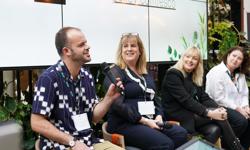The CEO panel, which was chaired by PPA chief executive Barry McIlheney, consisted of Time Inc’s Marcus Rich, Condé Nast’s Nicholas Coleridge, Hearst’s Anna Jones and Bauer’s Paul Keenan.
What was their plan b career? Marcus had always fancied turning his hand to prog-rock DJ and was a particular fan of post-Fish Marillion. Former journalist and would-be novelist Paul would write crime fiction à la Elmore Leonard; Anna would be an angel investor if only should could find the spare million or so required, whilst Nicholas, whose first year theology marks at university compared favourably with those of a certain Justin Welby, liked the idea of having a direct line to God, so for him, Archbishop of Canterbury was his fallback.
Back on earth, how are things looking in their chosen career of publishing? ‘Excitement’ and ‘growth’ were the themes of this session, as indeed they were throughout the day.
Anna Jones compared publishing to white water rafting. The pace of digital disruption was accelerating and we have to be prepared to pivot and change weekly. One of the highlights for her over the past twelve months had been the launch of Good Housekeeping Institute, where they had taken one of their oldest magazine brands and treated it like a start-up.
Nicholas Coleridge agreed that the pace of change was relentless and that, frankly, he didn’t know how he managed to fill his days five years ago.
At Time Inc, said Marcus Rich, they were now “permanently looking at completely different business models” and were now more prepared to take risks, presumably along the lines of the Marie Claire / Ocado tie up we heard about later in the day.
Thankfully, all this exciting change is resulting in growth. Hooray. In its 98th year, Vogue had just enjoyed its most profitable year ever, said Coleridge, and the company was growing its headcount. It had just taken on a hundred new staff to work on a “new project in Camden”. At Bauer, their new e-newsletter product, The Debrief, was experiencing exponential growth.
It was, said Anna Jones, a “fantastic time to work in magazine media”.
From the floor, the NRS’s Simon Redican wanted to know, if magazine media was growing revenue, which media was it taking it from? Who was going to lose out?
No one, said Paul Keenan, overall global revenue was increasing. Umm, hope so.
Rhapsody’s Les Pipe asked the panel when they expected to see the next large consumer magazine launch in print.
For Anna Jones, it depended on how he defined ‘large’, because last year they had launched Women’s Health and, in fact, were launching new print titles all the time.
Les was talking about the mega launches, the likes of Glamour (2001) and Nuts and Zoo (2004).
Pause.
Bauer’s Paul Keenan detected new confidence around the magazine industry. The launch of Magnetic, which he described as the single most important thing the industry has done over the last twelve months, meant that we were reconnecting with the advertising community. “Every advertiser I talk to,” he said “is keen to do that kind of innovation. A launch of scale will happen in the next 12-18 months.”
Now, I didn’t expect to hear that.
This semi-announcement will no doubt have pleased Egmont’s Gillian Laskier who asked about the differing level of engagement between print and digital. In her experience, readers were much less focused in digital than in print. So, shouldn’t publishers stop slapping their content on digital because it was undermining print?
For Marcus Rich, “stories are not read in isolation” and publishers had different relationships with readers across platforms”. Anna Jones stressed that Hearst publishes different content on different platforms, whilst Nicholas Coleridge thought publishers had no choice but to continue with both: “we’re all in the business of pleasing our readers in every way; we have to provide everything for everyone.”
Despite renewed optimism about the longevity and value of print, it is worth remembering that digital is where the growth is. Last year, Condé Nast saw 2% growth in print revenues, but 20% growth in digital.
Finally, in the roller coaster ride that is the world of publishing today, one thing remains constant, said Bauer’s Paul Keenan. Five years ago, it was the ‘year of mobile’ and publishers spent their time fretting over how to make money out of it. 2015 is once again the ‘year of mobile’ and, we’re still fretting over how to monetise it. Plus ça change.
More information about the PPA Festival, including a photo gallery of the day can be found here.












